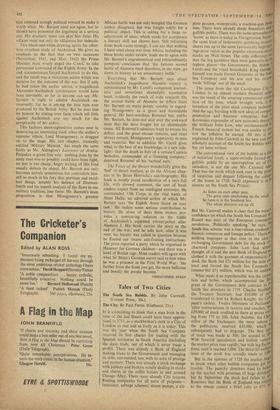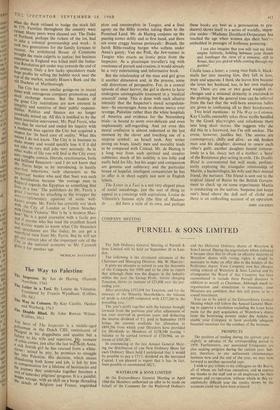Tales of Two Cities
The South Sea Bubble. By John Carswell. (Cresset Press, 30s.) The City. By Paul Ferris. (Gollancz, 21s.) IT is astonishing to think that a man born in the time of the last Stuart could have been appren- ticed, in 1711, as a stockbroker's clerk in a City of London as real and as lively as it is today. This was the year when the South Sea Company received its first charter for trading with the Spanish territories in South America (including the slave trade, out of which it never made a profit). There was already a Bank of England making loans to the Government and managing its debt, surrounded, too, with its aura of prestige and mystery. There was already a stock exchange with jobbers and brokers noisily dealing in stocks and shares in the coffee houses in and around Change Alley. There were already City tycoons floating companies for all sorts of puiposes- insurance, salvage schemes, Steam pumps, a tin- cBount fiMd ern. cCarswell o nw h cmha tkhees si to cu lteha r tah act otmh ep awnayv el:3! floated was part of the European commerd revolution. 'Politically speaking,' he says, South Sea scheme was a marvellous synthesis finance, commerce and foreign policy.' There Y'llet nothing improper at that time in the ideas, exchanging Government debt for the stock chartered company. John Law had alreo; thought of it and the new Bank of England br clothed it with the garment of respectabilitY. 'r deed, the Bank bid Of million for the debt CO tract and forced the South Sea CompanY I counter-bid £.74- million, which was its undo'a What made it so reprehensible was the coil tion and bribes which accompanied the Ow grant of the Government debt contract to South Sea directors in 1719. Charles StanhoPel' the Treasury Secretary, had £10.000 of stew transferred to him by Robert. Knight. the Colll pany's cashier. Twelve Members of Parliatnenj 'after conversations in taverns and coaches,' 1°, £39,000 of stock credited to them at prices Or; ing from 175 to 200. John Aislabie, the Cho; cellor of the Exchequer, the most odious the politicians, received £45,000, which rt subsequently had to disgorge. The first IS of stock was made at 300; the second at 4v,. With feverish speculation and bullish ruinow, the market price rose rapidly, but with big flucind, tions, until it reached 1,000. The third (£5 milliP„! issue of the stock was actually made at JR; But in the summer of 1720 the market bar,: to break when other bubble companies got trouble. The panicky directors tried to bolst,': up the market with promises of huge dividell°0 but by September the stock had fallen to 4,10 Rumours that the Bank of England was collo to the rescue caused a brief rally to 675. b plate process, waterproofs, a machine-gun in'," tion. There were already shady financiers and gullible public. There was the same atmosphere 'boom' as there is today in Throgmorton Street' the same kind of fashionable gambling in ego° shares run up to the same fantastically high areire ings-price ratios as the popular electronic-Mat stocks on Wall Street. The only difference,." that the big gamblers then were generally is highest places—the Government, the House I Lords, and the royal household. King George. himself was made formal Governor of the SOP Sea Company and his son and his inistre55 made 'killings' out of the stock. The jump from the old Carolingian City °I London to an almost modern financial ceatig was the result of the amazing commercial revolie tion of the time, which brought with it invention of the joint stock company techni40 And the age, bursting with new ideas of comP3. promotion and business enterprise, had 1,P, Keynesian expounder of new economic theorY the brilliant John Law, who revolutionised 1W French financial system but was unable to CO trot the inflation he started. All this is wr° explained by John Carswell in the best and till scholarly account of the South Sea Bubble %Old has yet been written. The conventional view of the bubble as a kind, of historical freak, a super-swindle foisted WI,: gullible public by an unscrupulous set of swindlers, is not the one Mr. Carswell takes, That was the myth which took root in the pee' of suspicion and despair following the collar: of the boom in 1720. Swift expressed it in stanzas on the South Sea Project:
As fishes on each other prey, The great ones swallowing up the small. So fares it in the Southern Sea, The whale directors eat up all.
When the Bank refused to budge the stock fell to 175. Families throughout the country were ruined. Many peers were cleaned out. The Duke of Portland, perhaps the richest of the lot, had to take a colonial governorship and work: it took two generations for the family fortunes to recover. An embittered House of Commons brought the main culprits to justice; but business enterprise in England was killed Until the Indus- trial Revolution got under way towards the end of the century. Only a few lucky speculators made huge profits by selling the bubble stock near the top of the market, notably Hoare's Bank and the old Duchess of Marlborough. The City has seen similar goings-on in recent times with outrageous company promotions and stock exchange booms. But the leaders of the great City institutions are now eminent in integrity and sensitive of their" public responsi- bilities. Politics and finance are no longer crookedly mixed up. All this is testified to by the latest journalist interviewer, Mr. Paul Ferris, who says that he started and ended his inquiry with a moderate bias against the City but acquired a respect for 'its hard core of reality.' What this Means I do not know. The City is in business to Make money and would quickly lose it if it did not take its very dull jobs very seriously. As in other walks of life you will find in the City every start—toughs, comics, liberals, reactionaries, fools and brilliant financiers—and I do not know that Air. Ferris helps us by introducing, in hastily sJiair.hed interviews, such characters as the important' banker who said that Suez was such ab.n humiliation because 'the average man in „cliglaild regards the Egyptian as something that Lives in a tree.' The publishers do Mr. Ferris a great J'sservice by attaching to the wrapper the rcr-
„ "`liplimentary opinions of some well-
u"11 People. Mr. Ferris has certainly not 'dealt With
the City of London as Lytton Strachey
hwitn , Queen Victoria.' Nor is he 'a modern May- evi. He is a good journalist with a facile pen sand it anyone who has read the excellent South a” Birbble wants to know what City financiers .nd speculators are like today, he can get a auPerricial view from Mr. Ferris. But he will not 8e.1 an Y correct idea of the important role of the .ItY in the national economy as Mr. Carswell gives it for another age.
NICHOLAS DAVENPORT



































 Previous page
Previous page